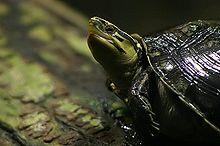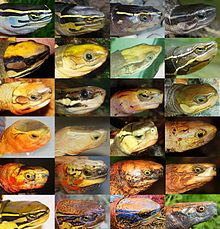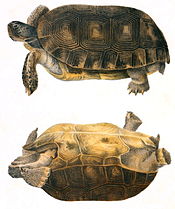- Asian box turtle
-
Asian box turtle 
Amboina box turtle, Cuora amboinensis Scientific classification Kingdom: Animalia Phylum: Chordata Class: Reptilia Order: Testudines Family: Geoemydidae Subfamily: Geoemydinae Genus: Cuora
Gray, 1856Species Around 10–11, see article.
Synonyms - Cistoclemmys
- Pyxiclemmys
Asian box turtles are turtles of the genus Cuora in the family Geoemydidae comprising 10–11 species with about the same number of subspecies. The keeled box turtle (Pyxidea mouhotii / Cuora mouhotii) is often included in this genus but is also often placed in its own genus (Pyxidea). The genus occurs from Assam throughout Southeast Asia and central to southern China northeastwards to Japan, and southeastwards to the borders of the Wallacea and onto Indonesia and the Philippines.
Contents
Description
Cuora species are characterized by a low (e.g. Cuora pani) to high (e.g. Cuora picturata) domed shell, which usually has three keels on the carapace. They are reddish, yellowish, brown grey and/or black in color. Some species have bright yellow, black, orange or white stripes down the length of the keels. Their body color is highly variable, but usually very intense. Most species show stripes of variable color down either side of the head, which usually meet at the nose.
Behavior
Asian box turtles are terrestrial, semi-aquatic or mainly aquatic, most spending much of their time on the edge of shallow swamps, streams or pond that are dense with vegetation. Most are omnivorous, but carnivores do occur.
 Head portrait of the different Cuora species, subspecies and varieties (from left to right/top to bottom):
Head portrait of the different Cuora species, subspecies and varieties (from left to right/top to bottom):
Cuora amboinensis amboinensis (Sulawesi), Cuora amboinensis kamaroma (Thailand), Cuora amboinensis ssp. (unknown), Cuora amboinensis ssp. (Philippines); Cuora trifasciata (Guangdong, China), Cuora aurocapitata (Anhui, China), Cuora pani pani (Shaanxi, China), Cuora yunnanensis (Yunnan, China); Cuora cyclornata cyclornata (Annam, central Vietnam), Cuora cyclornata meieri (north Vietnam), Cuora mccordi (Guangxi, China), Cuora zhoui (unknown); Cuora flavomarginata sinensis (Sichuan, China), Cuora flavomarginata evelynae (Ryukyu Islands, Japan), Cuora flavomarginata flavomarginata (Taiwan), Cuora picturata (southern Annam, south Vietnam); Cuora galbinifrons galbinifrons (north Vietnam), Cuora galbinifrons galbinifrons (Hainan, China); Cuora bourreti (Annam, central Vietnam), Cuora bourreti (Laos); Cuora cyclornata cyclornata × Cuora amboinensis kamaroma hybrid, Cuora cyclornata × Pyxidea mouhotii, Cuora trifasciata × Pyxidea mouhotii, Cuora galbinifrons × Pyxidea mouhotii = "Cuora serrata"Taxonomy and systematics
- Amboina box turtle, Cuora amboinensis (3 subspecies)
- Javanese box turtle, Cuora amboinensis couro
- Malayan box turtle, Cuora amboinensis kamaroma
- Lineated amboina box turtle, Cuora amboinensis lineata
- Vietnamese three-striped box turtle, Cuora cyclornata (1 subspecies)
- Northern Vietnamese or Meiers three-striped box turtle Cuora cyclornata meieri
- Yellow-margined box turtle, Chinese box turtle or snake-eating turtle, Cuora flavomarginata (2 subspecies)
- Ryukyu yellow margined box turtle, Cuora flavomarginata evelynae
- Chinese yellow margined box turtle, Cuora flavomarginata sinensis
- Indochinese (flowerback) box turtle, Cuora galbinifrons (1 subspecies)
- Central Vietnamese or Annam box turtle, Cuora (galbinifrons) bourreti
- Southern Vietnamese box turtle, Cuora picturata
- McCord's box turtle, Cuora mccordi
- Pan's box turtle, Cuora pani = "Cuora chriskarannarum" (1 "possible" subspecies)
- Yellow-headed or golden-headed box turtle, Cuora (pani) aurocapitata[Note 1]
- Chinese three-striped box turtle, Cuora trifasciata
- Yunnan box turtle, Cuora yunnanensis - rediscovered in 2004, verified in 2007.
- Zhou's box turtle, Cuora zhoui = "Cuora pallidicephala"
Cuora serrata, originally described as Cuora galbinifrons serrata by Iverson & Mccord[3] and later considered a distinct species by Obst & Fritz[4] are hybrids of the keeled box turtle and taxa of the Indochinese box turtle complex as shown by the genetic studies of Parham et al.[5] and Stuart & Parham (2004). A single specimen of Cuora serrata has been found in the wild,[6] lending credence to the possibility that other specimens arose through natural hybridization or even form wild populations. No Chinese turtle farm is known to produce C. serrata like specimens.[7] The occurrence of wild hybrids is often regarded as "evolution in progress", a terminology and point of view that is not always accepted. It has yet to be confirmed, whether all C. serrata from the wild have originated by direct hybridization of C. mouhotii and C. galbinifrons, or also by "hybridisation" of C. serrata × C. serrata.
Unnamed hybrids of several other Cuora taxa are also known,[Note 2] as are intergeneric hybrids like Mauremys iversoni,[8] a hybrid between Cuora trifasciata and Mauremys mutica which are intentionally produced in Chinese turtle farms.[5]
In captivity
Wild caught C. amboinensis were frequently available in the exotic animal trade but are getting rarer now, other species are rare to commercially extinct. Most species' need for a semi-aquatic environment can make them a challenge to house properly. These turtles are not suitable for beginners – the cute babies usually sold will rapidly grow to adulthood and in some species become hefty animals, no less than a Herman's tortoise in size – and specimens of unknown provenance and/or without sufficient CITES documentation may be illegal to keep. They are not often captive-bred, due to the high care requirements, but acclimatized captive-bred individuals can be quite hardy. It is also very important – as with Geoemydidae in general – to properly identify taxa and keep them separate, as the risk of putting considerable effort into breeding them only to end with sterile hybridas is otherwise very real. Especially Cuora trifasciata males have a reputation of attempting to mate with any anatomically roughly compatible turtle.[5]
Notes
- ^ Placed into subspecies status by Artner[1] and Blanck & Tang.[2]
- ^ See Vetter & Van Dijk (2006)[citation needed].
References
- ^ H. Artner (2004). "Haltung und Nachzucht von Pans Scharnierschildkröte Cuora pani pani Song, 1984 und der Goldkopf-Scharnierschildkröte Cuora pani aurocapitata Luo & Zong, 1988". Emys 11 (1): 4–21.
- ^ T. Blanck & M. Tang (2005). "Ein neuer Fundort von Cuora pani Song, 1984 mit Diskussion über den taxonomischen Status von Cuora pani und Cuora aurocapitata". Sacalia 7 (3): 16–37.
- ^ J. B. Iverson & W. P. McCord (1992). "A new subspecies of Cuora galbinifrons (Testudines: Batagurinae) from Hainan Island, China". Proceedings of the Biological Society of Washington 105: 433–439.
- ^ F. J. Obst & U. Fritz (1997). "Zum taxonomischen Status von Cuora galbinifrons serrata Iverson & McCord, 1992 und Pyxidea mouhotii (Gray, 1862)". Zoologische Abhandlungen (Museum für Tierkunde Dresden) 49 (2): 261–279.
- ^ a b c James Ford Parham, W. Brian Simison, Kenneth H. Kozak, Chris R. Feldman & Haitao Shi (2001). "New Chinese turtles: endangered or invalid? A reassessment of two species using mitochondrial DNA, allozyme electrophoresis and known-locality specimens". Animal Conservation 4 (4): 357–367. doi:10.1017/S1367943001001421. "Erratum". Animal Conservation 5 (1): 86. doi:10.1017/S1367943002001117.
- ^ H. Shi, J. F. Parham, W. B. Simison, J. Wang, S. Gong & B. Fu (2005). "A report on the hybridization between two species of threatened Asian box turtles (Testudines: Cuora) in the wild on Hainan Island (China) with comments on the origin of 'serrata'-like turtles". Amphibia-Reptilia 26 (3): 377–381.
- ^ Zhou et al. (2008)[citation needed]
- ^ Peter C. H. Pritchard & William P. McCord (1991). "A new emydid turtle from China". Herpetologica 47 (2): 138–147. JSTOR 3892730.
Further reading
- "Cuora amboinensis kamaroma", Rui Pessoa, 2007, Lisbon, Portugal
- Buskirk, James R.; Parham, James F. & Feldman, Chris R. (2005): On the hybridisation between two distantly related Asian turtles (Testudines: Sacalia × Mauremys). Salamandra 41: 21-26. PDF fulltext
External links
Geoemydidae family of turtles Genus Species of the Geoemydidae family
Batagur Burmese roofed turtle · Northern river terrapin · Painted terrapin · Red-crowned roofed turtle · Southern river terrapin · Three-striped roofed turtleCuora Amboina box turtle · Bourret's box turtle · Ryukyu yellow-margined box turtle · Indochinese box turtle · McCord's box turtle · Keeled box turtle · Pan's box turtle · Southern Vietname box turtle · Chinese three-striped box turtle · Yellow-headed box turtle · Yellow-margined box turtle · Yunnan box turtle · Zhou's box turtleCyclemys Geoclemys Spotted pond turtleGeoemyda Black-breasted leaf turtle · Ryukyu black-breasted leaf turtleHardella Crowned river turtleHeosemys Leucocephalon Malayemys Malayan snail-eating turtle · Mekong snail-eating turtleMauremys Melanochelys Morenia Notochelys Orlitia Pangshura Assam roofed turtle · Brown roofed turtle · Indian roofed turtle · Indian tent turtleRhinoclemmys Black river turtle · Brown wood turtle · Colombian wood turtle · Furrowed wood turtle · Large-nosed wood turtle · Maracaibo wood turtle · Mexican spotted wood turtle · Painted wood turtle · Spot-legged turtleSacalia Siebenrockiella Black marsh turtle · Philippine forest turtleVijayachelys Phylogenetic arrangement of turtles based on turtles of the world 2010 update: annotated checklist of taxonomy, synonymy, distribution and conservation status.Order Testudines (turtles) Suborder SuperfamilySubfamily
Cryptodira Chelydra · MacrochelysCaretta · Chelonia · Eretmochelys · Lepidochelys · NatatorDermochelysDermatemydidaeDermatemysStaurotypinaeClaudius · StaurotypusBatagur · Cuora · Cyclemys · Geoclemys · Geoemyda · Hardella · Heosemys · Leucocephalon · Malayemys · Mauremys · Melanochelys · Morenia · Notochelys · Orlitia · Pangshura · Rhinoclemmys · Sacalia · Siebenrockiella · VijayachelysAldabrachelys · Astrochelys · Chelonoidis · Chersina · Cylindraspis · Geochelone · Gopherus · Homopus · Indotestudo · Kinixys · Malacochersus · Manouria · Psammobates · Pyxis · Stigmochelys · TestudoTrionychiaCarettochelyidaeCarettochelysTrionychinaePleurodira ChelidinaeChelodininaeHydromedusinaePelomedusa · PelusiosPhylogenetic arrangement based on turtles of the world 2010 update: annotated checklist. Extinct turtles not included.
See also List of Testudines families
 Portal ·
Portal ·  WikiProjectCategories:
WikiProjectCategories:
Wikimedia Foundation. 2010.
